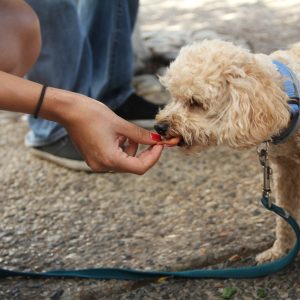Our dogs mean the world to us. If we could stop them from aging or feeling pain, we would. Sounds impossible, right? Yes and no. They’re going to get older despite our best efforts. That means all of the aches and pains that go along with aging. However, glucosamine for dogs can provide relief from some of the worst aging does to our dogs.
Aging and Arthritis
Have you heard a “pop” when your dog’s gotten up? Does it sound familiar? (I don’t know about you, but it sounds like a condemned house when I get up) That creaking signifies the onset of osteoarthritis – the fancy medical term for arthritis.
We all hate it, but arthritis is part of the natural aging process. The cartilage (natural cushioning between bones) thins and starts wearing down. The bones then rub against each other (ouch!). Previous trauma or orthopedic disease accelerates this process. (Which is why younger dogs get arthritis)
You see a lot of different signs:
- Trouble sitting or getting up
- Difficulty jumping
- Opting for shorter and shorter walks
- Refusal to use stairs
- Limping
- Lethargy or inactivity
- Depression
- Tenderness in the affected area
Note: Arthritis affects both large and small dogs equally.
Glucosamine and Arthritis
Glucosamine is a molecule produced in the body. The body uses glucosamine as a building block for cartilage and synovial fluid. (Yay!) Synovial fluid helps keep joints moving smoothly. However, as the body ages, the production of glucosamine slows down. (Boo!)
Providing glucosamine as a supplement for your dog steps into that gap. The same system of repair continues to function. Glucosamine also scavenges free radicals. As such, it provides mild anti-inflammatory effects (i.e., pain relief). One little supplement helps restore healthy cartilage AND provides pain relief. Not too shabby!
Glucosamine and Chondroitin – BFFs
Now, odds are you won’t see straight glucosamine anywhere. Most supplements pair glucosamine with chondroitin sulfate. Chondroitin is another compound found in the body. It blocks destructive enzymes that break down cartilage. (That’s helpful – we want that) Chondroitin also helps cartilage retain water and stay elastic. The result is a joint that absorbs shock appropriately and stays adequately nourished.
The Science of Glucosamine in Dogs
Other than commercials and fancy ads in magazines, why don’t you see more about glucosamine? Well, there aren’t many studies with glucosamine. A couple compared the supplement against standard medical therapy for arthritis in dogs, but that’s about it. Yet vets recommend it all the time? Well, yeah. So why aren’t more vets studying it?
Glucosamine and chondroitin are a class of supplements called nutraceuticals. A nutraceutical is an alternative to prescription medication. They can’t be patented. Since there’s no patent available, there’s no money for pharmaceutical companies. No money, no desire to fund research. Research needs money to operate. It’s a nasty little circle. Does this mean glucosamine isn’t effective? No, of course not. It just means there isn’t a lot of science backing it up.
Hydrochloride vs. Sulfate
Astute owners might notice a difference between brands of supplements. Glucosamine comes in two “flavors,” if you will: glucosamine hydrochloride and glucosamine sulfate. The sulfate version used to be the most common one out there. Why? It’s easier for your dog to digest.
However, Dr. Matt Brunke, a veterinary specialist in sports medicine, rehabilitation, and pain management (that’s what all of those letters mean), speaks a lot about glucosamine. And it turns out the sulfate version doesn’t even reach the joints!
“A joint supplement doesn’t help if it doesn’t get where it needs to be.”
~Matt Brunke, DVM, CRRP, CVPP, CVA
For that reason, Dr. Brunke recommends supplementation with glucosamine hydrochloride for dogs. As long as your dog eats when he gets his supplement, he shouldn’t get an upset stomach. Best of all, the glucosamine will reach his joints. And that’s what you’re healing, right?
Selecting the Right Glucosamine in Your Dog
Before you start your dog on glucosamine, chat with your vet. While this is a supplement and a prescription isn’t required, you’re still medicating your dog. Discuss the signs you’re seeing (those symptoms MIGHT mean something else), and talk about proper dosing. It IS possible to overdose on glucosamine. You also want to make sure the supplement won’t interfere with any other medications they’re taking.
Glucosamine for dogs come in a lot of different forms:
- Chewable tablets
- Pills
- Powders you sprinkle on their food
- Liquids
Supplements AREN’T regulated by the FDA. As such, not all supplements are created equal. Some commercial brands don’t contain the amounts they advertise. Different brands contain different amounts of their components. Brands ordered at discounted prices may come from overseas and contain toxins. You want to do your homework.
My recommendation? Choose a brand using lab-grade glucosamine and chondroitin, with ingredients sourced from countries with strict regulatory oversight and testing.
Things to be aware of:
- Avoid supplements using shark cartilage. Sharks are a vital ocean resource, and there’s NO extra benefit.
- Avoid human supplements. Human versions often contain Xylitol, which is TOXIC to dogs.
- Don’t suddenly switch from one supplement to the next. Remember, the amounts of glucosamine won’t be the same.
- Watch the calories if you use treats. Sometimes you have to give a lot to reach the appropriate dose, and packing on extra pounds isn’t good for your dog’s joints.
The Natural Alternative
If you’re uncertain about trusting commercial supplements, you can provide glucosamine to your dog naturally. After all, it’s a natural compound.
First things first, though, you need to go to healthy, pastured animals (no factory livestock). You want quality sources to avoid possible contamination. That means skipping pre-packaged options.
Glucosamine is high in these sources:
- Chicken feet
- Oxtails
- Beef knuckle bones
- Tracheas
- Green-lipped mussels
- Wild-caught shellfish
NEVER give cooked bones to your dog! They’re a severe health hazard. Feed them raw (please observe all health precautions for you and your family). And, yes, even this route – you still have to talk to your vet.
Supplements and Patience
We hate seeing our dogs in pain. Glucosamine for dogs has the potential to ease and heal the pain of arthritis.
However, you need to be patient.
Nothing works immediately, and glucosamine and chondroitin are no exception. As Dr. Brunke admits, they work in dogs, but it takes time. (Cartilage is NOT built in a day) It can take up to THREE MONTHS for you to see results.
Talk to your vet. They can provide additional therapy while you patiently wait for the glucosamine to kick in. You can always wean it off down the road. The important thing is that you’re trying your best for your best friend.
Then you’ll be the only one creaking in the morning!
Check out our recommendations for best joints supplements for dogs.













No comment yet, add your voice below!